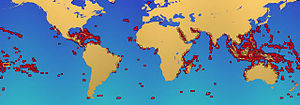Coral Bleaching the Great Barrier Reef.
The Great Barrier Reef which is made up of around 2,900 individual reefs along with 900 islands having the length over 1,600 miles (2,600 kilometers) has an area of almost 133,000 square miles (344,400 square kilometers ).
The figures explain the reason why it is the largest reef in the world.
The reef is situated in the Coral Sea, near to Queensland in northeast Australia and the only place in the whole earth which can be detected from the outer space.

The Great Barrier Reef is the largest structure made by the living creatures named coral polyps. In 1981, it was nominated as a World Heritage Site.
The Great Barrier Reef is a habitation of diversity of life including more than 1,500 fish species, thirty species of whales, the dwarf minke whale, Indo-Pacific humpback dolphins, the endangered dugongs, clownfish, red bass, red-throat emperor, and forty-nine species mass spawn, numerous species of snapper, coral trout, sea snake and many more.
According to BBC News, 2nd October, 2012 the Great Barrier Reef has already bleached over half of its coral cover in the last 27 years.
The results show that coral cover declined from 28.0% to 13.8% between 1985 and 2012.
A research published in the Proceedings of the National Academy of Sciences journal claimed that after analyzing on the condition of 217 coral reefs.
The outcomes disclosed that coral cover from 28% to 13.8% – an average of 0.53% a year which done a total loss of 50.7% in the past 27-year period.
The main reasons of the coral bleaching are storms, an outbreak of coral-feeding starfish and climate change. The observations are done over 2,000 surveys of 214 reefs between 1985 and 2012.
The Great Barrier Reef forms the most productive ecosystem.
But the reef faces the bleaching problem for the last several years due to the climate change, pollution, outbreak of crown-of-thorns starfish and fishing, shipping accidents, oil spills, and tropical cyclones, Skeletal Eroding Band, a disease of bony corals.
The greatest peril to the Great Barrier Reef is to be the climate change like ocean warming.
Mass coral bleaching had already been occurred in the summer of 1998, 2002 and 2006. Pollution and declining water quality are the other crucial danger faced by the Great Barrier Reef.
The flood water brought more than 90% of this pollution through farm runoff including overgrazing, excessive fertilizer, and pesticide. The crown-of-thorns starfish kills the coral polyps which are the main reef building ingredients.
According to a study by the RRC (Reefs Research Centre) an outbreak of the crown-of-thorns starfish made a loss of 66% of live coral, in 2000.
Fishing and shipping are also threating to the coral life.







